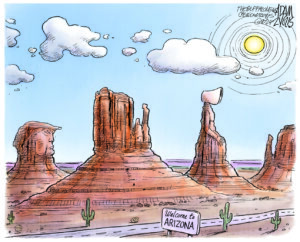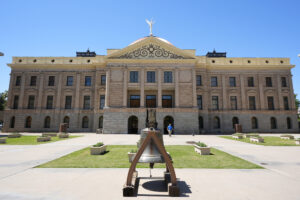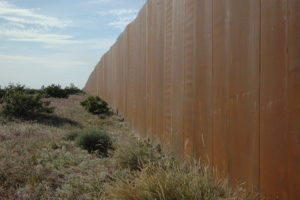Trump Working With Governors to Send Troops to Guard Border
The announcement comes after the president pledges "strong action today" on immigration and a day after he proposed using the military to secure the southern border until his border wall was erected.WASHINGTON — President Trump and border-state governors are working to “immediately” deploy the National Guard to the U.S.-Mexico border to fight illegal immigration, Homeland Security Secretary Kirstjen Nielsen said Wednesday.
“The threat is real,” Nielsen said, adding that Trump was signing a proclamation to put the deployment into effect. “It’s time to act.”
The announcement came hours after Trump pledged “strong action today” on immigration and a day after he said he wanted to use the military to secure the southern border until his long-promised border wall is erected.
Nielsen said she’s been in touch with governors on the southwest border states and has been working with them to develop agreements that will oversee where and how many Guardsmen will be deployed. She suggested some troops could begin arriving as soon as Wednesday night, though other administration officials cautioned that details on troop levels, locations and timing were still being worked out.
“We do hope that the deployment begins immediately,” she said.
Trump has been frustrated by slow action on building his “big, beautiful wall” along the Mexican border — the signature promise of his campaign — as well as a recent uptick in illegal border crossings that had plunged during the early months of his presidency. He has also been fixated on the issue of border security since he grudgingly signed a spending bill last month that includes far less money for the wall than he’d hoped for.
Federal law prohibits the use of active-duty service members for law enforcement inside the U.S., unless specifically authorized by Congress. But over the past 12 years, presidents have twice sent National Guard troops to the border to bolster security and assist with surveillance and other support.
Nielsen said the effort would be similar to a 2006 operation in which President George W. Bush deployed troops to help U.S. Customs and Border Protection personnel with non-law enforcement duties while additional border agents were hired and trained. President Barack Obama also sent about 1,200 troops in 2010 to beef up efforts against drug smuggling and illegal immigration.
Nielsen said her department had developed a list of locations where it would like assistance and was discussing with the governors how to facilitate the plans. She declined to say how many personnel would be needed or how much the operation would cost, but she insisted, “It will be as many as is needed to fill the gaps that we have today.”
One congressional aide said that lawmakers anticipate 300 to 1,200 troops will be deployed and that the cost of the deployment was expected to be at least $60 million to $120 million a year. The Pentagon can likely reprogram funds in the short term but would probably need authorization from Congress beyond a few months, said the aide, who wasn’t authorized to speak publicly and spoke on condition of anonymity.
The Republican governors of Texas and Arizona applauded the move, while New Mexico Gov. Susana Martinez, also a Republican, didn’t immediately comment on it. Democratic Gov. Jerry Brown of California, who has been sparring with Trump over immigration policies, is likely to oppose it.
Trump first revealed Tuesday that he’d been discussing the idea of using the military at the border with Defense Secretary Jim Mattis.
“We’re going to be doing things militarily. Until we can have a wall and proper security, we’re going to be guarding our border with the military,” Trump said, calling the move a “big step.”
He spent the first months of his presidency bragging about a dramatic drop in illegal border crossings, which some DHS officials had even dubbed the “Trump effect.” Indeed, arrests at the border last April were at the lowest level since the Homeland Security Department was created in 2003, and the 2017 fiscal year saw a 45-year low for Border Patrol arrests.
But the numbers have been slowly ticking up since last April and are now on par with many months of the Obama administration. Statistics show 36,695 arrests of people trying to cross the southwest border in February 2018, up from 23,555 in the same month of the previous year.
Trump’s new focus on hard-line immigration policies appears aimed, at least in part, in drawing a political contrast with Democrats heading into the midterm elections. He has also been under growing pressure from conservative backers who have accused him of betraying his base for not delivering on the wall, and he was set off by images played on his favorite network, Fox News, of a “caravan” of migrants making their way through Mexico.
On Capitol Hill, many Republicans embraced the move.
House Homeland Security Chairman Michael McCaul, R-Texas, called the plan “a positive step toward providing the safety this nation has long demanded.” And Texas Sen. John Cornyn, the No. 2 Republican in the Senate, called it “a common-sense way to temporarily assist law enforcement along the border.”
But Astrid Dominguez, director of the ACLU Border Rights Center, slammed it as “another impulsive reaction to not getting his way on his border wall” and “a dangerous move, contrary to the fundamental norms of a civil society.”
In Texas, which already has about 100 National Guard members stationed on the border, Gov. Greg Abbott, praised the president’s decision.
“Today’s action by the Trump Administration reinforces Texas’ longstanding commitment to secure our southern border and uphold the Rule of Law, and I welcome the support,” he said.
Arizona Gov. Doug Ducey tweeted that his state “welcomes the deployment of National Guard to the border. Washington has ignored this issue for too long and help is needed.”
___
Associated Press writers Lolita C. Baldor, Matthew Daly and Robert Burns in Washington and Nomaan Merchant in Houston contributed to this report.
Your support matters…Independent journalism is under threat and overshadowed by heavily funded mainstream media.
You can help level the playing field. Become a member.
Your tax-deductible contribution keeps us digging beneath the headlines to give you thought-provoking, investigative reporting and analysis that unearths what's really happening- without compromise.
Give today to support our courageous, independent journalists.






You need to be a supporter to comment.
There are currently no responses to this article.
Be the first to respond.